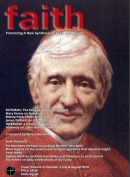The Mother of God and the Annunciation
FAITH Magazine March – April 2011
As the source of all being, God, in his divinity, does not have a mother. If he did she would be God, (and we're not going down that avenue here!). In his humanity however he does have a mother. Mary has been called "Mother of God" from the Council of Ephesus in 431 AD onwards. This title emphasises that her son, Jesus, who has two ways of being (two natures: divine and human), is just one person, the eternal divine, Son of God.
The title then is shorthand for: Jesus is God and Mary is Jesus’ true human mother. The Council of Ephesus was condemning the opinion of a powerful bishop of Constantinople, Nestorius, who felt that there were two persons in Jesus and would only call Mary "Mother of Christ". This seemed to undermine whether 'Christ' was really divine, which had been defined by the Council of Nicea (325 AD) against the Arian heresy. So the Council of Ephesus defined with the full authority of Christ in His Church, that he was "born of the Father before the ages according to divinity, but in the latest days he was born of the Virgin Mary, the Mother of God, according to the humanity".
The title had already been in use for two hundred years. One hundred years before (c. 339AD). St. Athanasius, Bishop of Alexandria, had had to defend the divinity of Christ against the extremely widespread Arian heresy that saw Jesus as just the highest human being. Athanasius wrote:
"The Word 'took to himself descent from Abraham', as the Apostle says, 'and therefore it was essential that he should in this way become completely like his brothers', and take a body similar to us. That is why Mary is really part of his plan, so that he may take his body from her and offer it up as something that is his own. Accordingly scripture mentions his birth, and says: 'She wrapped him up in swaddling clothes; the breasts that suckled him were called blessed'."
God needs the womb in Mary to complete his plan of creation and salvation. The feminine indeed has an exalted place in God's plan. Through and with Mary womanhood enables God to give us the fullness of life. The catechism tells us that "to prepare a body for [His Son, God] wanted the free cooperation of a creature. For this, from all eternity God chose for the mother of his Son a daughter of Israel, a young Jewish woman of Nazareth in Galilee." So fundamental is the cooperation of her whole person, womb and will, that she was "predestined".
St. Ambrose, Bishop of Milan, also of the fourth century, saw Mary as a sign and image of the Church, in that in giving birth to Christ she also brought forth Christians who were formed in her womb with Him. After the Council of Ephesus these thoughts of the two earlier Bishops Athanasius and Ambrose gained much impetus to become the great Catholic tradition of Marian reflection and piety.

